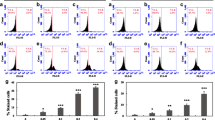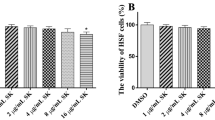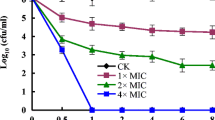Abstract
Amentoflavone was isolated from an ethyl acetate extract of the whole plant of Selaginella tamariscina. It is a traditional herb for the therapy of chronic trachitis and exhibits some anti-tumor activity. Previously, we confirmed the antifungal effects of amentoflavone. The objective of this study was to investigate the antifungal mechanism(s) of amentoflavone, such as mitochondria-mediated apoptotic cell death. The cells that were treated with amentoflavone exhibited a series of cellular changes that were consistent with apoptosis: externalization of phosphatidylserine, DNA and nuclear fragmentation, accumulation of intracellular reactive oxygen species (ROS) and hydroxyl radicals, and activation of metacaspase. In addition, diagnostic markers of apoptosis, including the reduction of mitochondrial inner-membrane potential and the release of cytochrome c from mitochondria, were observed. These phenomena are important changes in mitochondria-mediated apoptosis. Furthermore, the effect of thiourea as hydroxyl radical scavenger on amentoflavone-induced apoptosis was evaluated. A hydroxyl radical is a more active ROS species. Mitochondrial dysfunction was inhibited, which was indicated by decreased levels of intracellular hydroxyl radicals. Taken together, our results present the first evidence that amentoflavone induces apoptosis in C. albicans cells and is associated with the mitochondrial dysfunction. Besides, amentoflavone-induced hydroxyl radicals may play a significant role in mitochondria-mediated apoptosis.







Similar content being viewed by others
Abbreviations
- ROS:
-
Reactive oxygen species
- DHR-123:
-
Dihydrorhodamine
- HPF:
-
2-[6-(4′-hydroxy) phenoxy-3H-xanthen-3-on-9-yl] benzoic acid
- DAPI:
-
4′-6-Diamidino-2-phenylindole
- TUNEL:
-
Terminal deoxynucleotidyl transferase dUTP nick end labeling
- DiOC6(3):
-
3,3′-Dihexyloxacarbocyanine iodide
- AMB:
-
Amphotericin B
- PI:
-
Propidium iodide
References
Chiou CC, Groll AH, Walsh TJ. New drugs and novel targets for treatment of invasive fungal infections in patients with cancer. Oncologist. 2000;5:120–2.
Cowen LE, Anderson JB, Kohn LM. Evolution of drug resistance in Candida albicans. Annu Rev Microbiol. 2002;56:139–65.
Gislene GFN, Juliana L, Paulo CF, Giuliana LS. Antibacterial activity of plant extracts and phytochemicals on antibiotic resistant bacteria. Braz J Microbiol. 2000;31:247–56.
Khan ZS, Nasreen S. Phytochemical analysis, antifungal activity and mode of action of methanol extracts from plants against pathogens. J Agric Technol. 2010;6:793–805.
Phillips AJ, Sudbery I, Ramsdale M. Apoptosis induced by environmental stresses and amphotericin B in Candida albicans. Proc Natl Acad Sci USA. 2003;100:14327–32.
Phillips AJ, Crowe JD, Ramsdale M. Ras pathway signaling accelerates programmed cell death in the pathogenic fungus Candida albicans. Proc Natl Acad Sci USA. 2006;103:726–31.
Wu XZ, Chang WQ, Cheng AX, Sun LM, Lou HX. Plagiochin E, an antifungal active macrocyclic bis(bibenzyl), induced apoptosis in Candida albicans through a metacaspase-dependent apoptotic pathway. Biochim Biophys Acta. 2010;1800:439–47.
Gambhir SS, Goel RK, Das Gupta G. Anti-inflammatory and anti-ulcerogenic activity of amentoflavone. Indian J Med Res. 1987;85:689–93.
Lin LC, Kuo YC, Chou CJ. Cytotoxic Biflavonoids from Selaginella delicatula. J Nat Prod. 2000;63:627–30.
Jung HJ, Sung WS, Yeo SH, Kim HS, Lee IS, Woo ER, Lee DG. Antifungal effect of amentoflavone derived from Selaginella tamariscina. Arch Pharm Res. 2006;9:746–51.
Silva GL, Chai H, Gupta MP, Farnsworth NR, Cordell GA, Pezzuto JM, Beecher CW, Kinghorn AD. Cytotoxic biflavonoids from Selaginella willdenowii. Phytochemistry. 1995;40:129–34.
Markham KR, Sheppard C, Geiger H. 13C NMR studies of some naturally occurring amentoflavone and hinokiflavone biflavonoids. Phytochemistry. 1987;26:3335–7.
Jung HJ, Park K, Lee IS, Kim HS, Yeo SH, Woo ER, Lee DG. S-phase accumulation of Candida albicans by anticandidal effect of amentoflavone isolated from Selaginella tamariscina. Biol Pharm Bull. 2007;10:1969–71.
Schiller M, Blank N, Heyder P, Herrmann M, Gaipl US, Kalden JR, Lorenz HM. Induction of apoptosis by spermine-metabolites in primary human blood cells and various tumor cell lines. Apotosis. 2005;10:1151–62.
Heatwole VM. TUNEL assay for apoptotic cells. Methods Mol Biol. 1999;115:141–8.
Park C, Lee DG. Melittin induces apoptotic features in Candida albicans. Biochem Biophys Res Commun. 2010;394:170–2.
Michael P, John JR, Ann MS, David K. Monitoring singlet oxygen and hydroxyl radical formation with fluorescent probes during photodynamic therapy. Photochem Photobiol. 2009;85:1177–81.
Matthew W, Barry H. Thiourea and dimethyl thiourea inhibit peroxynitrite-dependent damage: nonspecificity as hydroxyl radical scavengers. Free Radic Biol Med. 1997;22:1309–12.
Niimi K, Harding DR, Parshot R, King A, Lun DJ, Decottignies A, Niimi M, Lin S, Cannon RD, Goffeau A, Monk BC. Chemosensitization of fluconazole resistance in Saccharomyces cerevisiae and pathogenic fungi by a D-octapeptide derivative. Antimicrob Agents Chemother. 2004;48:1256–71.
Dumont ME, Schlichter JB, Cardillo TS, Hayes MK, Bethlendy G, Sherman F. CYC2 encodes a factor involved in mitochondrial import of cytochrome c. Mol Cell Biol. 1993;13:6442–51.
N’cho M, Brahmi Z. Evidence that Fas-induced apoptosis leads to S phase arrest. Hum Immunol. 2001;62:310–9.
Iguchi T, Miyakawa Y, Saito K, Nakabayashi C, Nakanishi M, Saya H, Ikeda Y, Kizaki M. Zoledronate-induced S phase arrest and apoptosis accompanied by DNA damage and activation of the ATM/Chk1/cdc25 pathway in human osteosarcoma cells. Int J Oncol. 2007;31:285–91.
Madeo F, Frohlich E, Frohlich KU. A yeast mutant showing diagnostic markers of early and late apoptosis. J Cell Biol. 1997;139:729–34.
Cabiscol E, Piulats E, Echave P, Herrero E, Ros J. Oxidative stress promotes specific protein damage in Saccharomyces cerevisiae. J Biol Chem. 2000;275:27393–8.
Ribeiro GF, Côrte-Real M, Johansson B. Characterization of DNA damage in yeast apoptosis induced by hydrogen peroxide, acetic acid, and hyperosmotic shock. Mol Biol Cell. 2006;17:4584–91.
Ludovico P, Sousa MJ, Silva MT, Leao C, Corte-Real M. Saccharomyces cerevisiae commits to a programmed cell death process in response to acetic acid. Microbiology. 2001;147:2409–15.
Frohlich KU, Madeo F. Apoptosis in yeast-a monocellular organism exhibits altruistic behavior. FEBS Lett. 2000;473:6–9.
Madeo F, Fröhlich E, Ligr M, Grey M, Sigrist SJ, Wolf DH, Fröhlich KU. Oxygen stress: a regulator of apoptosis in yeast. J Cell Biol. 1999;145:757–67.
Sakurada H, Koizumi H, Ohkawara A, Ueda T, Kamo N. Use of dihydrorhodamine 123 for detecting intracellular generation of peroxides upon UV irradiation in epidermal keratinocytes. Arch Dermatol Res. 1992;284:114–6.
Haruna S, Kuroi R, Kajiwara K, Hashimoto R, Matsugo S, Tokumaru S, Kojo S. Induction of apoptosis in HL-60 cells by photochemically generated hydroxyl radicals. Bioorg Med Chem Lett. 2002;12:675–6.
Zivna L, Krocova Z, Härtlova A, Kubelkova K, Zakova J, Rudolf E, Hrstka R, Macela A, Stulik J. Activation of B cell apoptotic pathways in the course of Francisella tularensis infection. Microb Pathog. 2010;49:226–36.
Barroso G, Taylor S, Morshedi M, Manzur F, Gaviño F, Oehninger S. Mitochondrial membrane potential integrity and plasma membrane translocation of phosphatidylserine as early apoptotic markers: a comparison of two different sperm subpopulations. Fertil Steril. 2006;85:149–54.
Vayssiere JL, Petit PX, Risler Y, Mignotte B. Commitment to apoptosis is associated with changes in mitochondrial biogenesis and activity in cell lines conditionally immortalized with simian virus 40. Proc Natl Acad Sci USA. 1994;91:11752–6.
Zamzami N, Marchetti P, Castedo M, Hirsch T, Susin SA, Masse B, Kroemer G. Inhibitors of permeability transition interfere with the disruption of the mitochondrial transmembrane potential during apoptosis. FEBS Lett. 1996;384:53–7.
Douma S, Van Laar T, Zevenhoven J, Meuwissen R, Van Garderen E, Peeper DS. Suppression of anoikis and induction of metastasis by the neurotrophic receptor TrkB. Nature. 2004;430:1034–9.
Duval R, Bellet V, Delebassée S, Bosgiraud C. Implication of caspases during maedi-visna virus-induced apoptosis. J Gen Virol. 2002;83:3153–61.
Smrz D, Dráberová L, Dráber P. Non-apoptotic phosphatidylserine externalization induced by engagement of glycosylphosphatidylinositol-anchored proteins. J Biol Chem. 2007;282:10487–97.
Pozniakovsky AJ, Knorre DA, Markova OV, Hyman AA, Skulachev VP, Severin FF. Role of mitochondria in the pheromone- and amiodarone-induced programmed cell death of yeast. J Cell Biol. 2005;168:257–69.
Ludovico P, Rodrigues F, Almeida A, Silva MT, Barrientos A, Côrte-Real M. Cytochrome c release and mitochondria involvement in programmed cell death induced by acetic acid in saccharomyces cerevisiae. Mol Biol Cell. 2002;13:2598–606.
Benaroudj N, Lee DH, Goldberg AL. Trehalose accumulation during cellular stress protects cells and cellular proteins from damage by oxygen radicals. J Biol Chem. 2001;276:24261–7.
Liang J, Wu WL, Liu ZH, Mei YJ, Cai RX, Shen P. Study the oxidative injury of yeast cells by NADH autofluorescence. Spectrochim Acta A Mol Biomol Spectrosc. 2007;67:355–9.
Novogrodsky A, Ravid A, Rubin AL, Stenzel KH. Hydroxyl radical scavengers inhibit lymphocyte mitogenesis. Proc Natl Acad Sci USA. 1982;79:1171–4.
Repine JE, Fox RB, Berger EM. Hydrogen peroxide kills Staphylococcus aureus by reacting with staphylococcal iron to form hydroxyl radical. J Biol Chem. 1981;256:7094–6.
Touati D, Jacques M, Tardat B, Bouchard L, Despied S. Lethal oxidative damage and mutagenesis are generated by iron in delta fur mutants of Escherichia coli: protective role of superoxide dismutase. J Bacteriol. 1995;177:2305–14.
Pereira C, Camougrand N, Manon S, Sousa MJ, Côrte-Real M. ADP/ATP carrier is required for mitochondrial outer membrane permeabilization and cytochrome c release in yeast apoptosis. Mol Microbiol. 2007;66:571–82.
Adrian C, Martin SJ. The mitochondrial apoptosome: a killer unleashed by the cytochrome seas. Trends Biochem Sci. 2001;26:390–7.
Desagher S, Martinou JC. Mitochondria as the central control point of apoptosis. Trends Cell Biol. 2000;10:369–77.
Vander Heiden MG, Chandel NS, Williamson EK, Schumacker PT, Thompson CB. Bcl-xL regulates the membrane potential and volume homeostasis of mitochondria. Cell. 1997;91:627–37.
Chen Q, Takeyama N, Brady G, Watson AJM, Dive C. Blood cells with reduced mitochondrial membrane potential and cytosolic cytochrome c can survive and maintain clonogenity given appropriate signals to suppress apoptosis. Blood. 1998;92:4545–53.
Acknowledgments
This work was supported by the National Research Foundation of Korea (NRF) grant funded by the Korea government (MEST) (No. 2011-0000915).
Author information
Authors and Affiliations
Corresponding author
Rights and permissions
About this article
Cite this article
Hwang, Is., Lee, J., Jin, HG. et al. Amentoflavone Stimulates Mitochondrial Dysfunction and Induces Apoptotic Cell Death in Candida albicans . Mycopathologia 173, 207–218 (2012). https://doi.org/10.1007/s11046-011-9503-x
Received:
Accepted:
Published:
Issue Date:
DOI: https://doi.org/10.1007/s11046-011-9503-x




